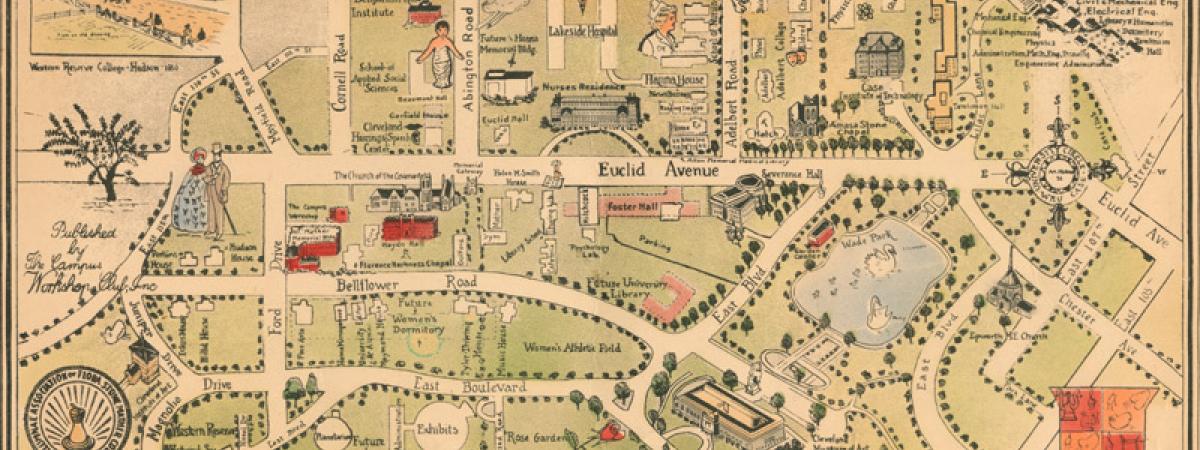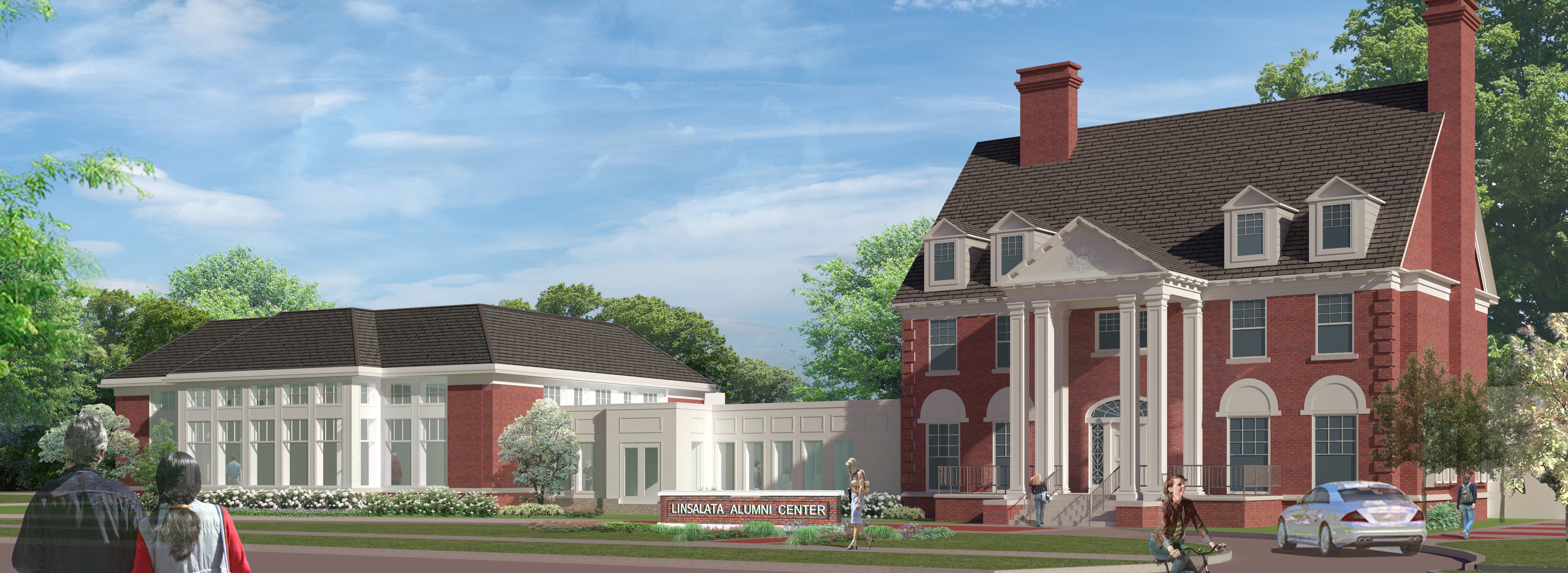The Linsalata Alumni Center was created to provide Case Western Reserve University, its alumni and the community with a home away from home, while encouraging interest in and support of CWRU.
Every Campus Needs an Alumni House
In the early 1990s, Case Western Reserve University’s alumni leadership talked about the need for an alumni house. The goal of the program was to create a location on campus where alumni could gather, host events and meetings and include a place of recognition honoring prominent distinguished alumni. When considering other universities, most had a place for alumni to spend time when they returned to campus.
The university supported the idea. In 1996, the search began for a campus location for an alumni house. Various locations were considered, including: the Green House Restaurant that was purchased by the university in 1997; moving Hitchcock House from its present location to the east side of Thwing Center; and building a new facility. Although the formal campaign launched a few years later, the first gift for the Alumni House was received in 1997 from an alum in San Diego, Calif.
In 2001, the university’s board of trustees approved the Alumni House project in concept. CWRU Development Officer Jim Conway and Dan Clancy (LAW ’62), CWRU’s assistant vice president for alumni relations in 2001, met with Ted Castele (ADL ’51, MED ’57) and Don Foster (ADL ’50) to request their support and encourage them to oversee a fundraising campaign for the Alumni House. They jointly pledged $1 million to create the Foster-Castele Great Hall, intended to be the large function space. In addition to Castele and Foster, lead donors included George Leet (ADL ’40, LAW ’46) and Eric Nord (CIT ’39), both of whom pledged $1 million dollars.
In 2003, a $10 million dollar campaign was launched to construct a new alumni house on Euclid Avenue, to be located between Thwing Center and the Church of the Covenant. The design called for a circle drive in front of the house to drop-off visitors. When fundraising got off to a slow start, Castele and Foster expressed their concerns about the progress of the project and put temporary holds on their pledges. In the midst of presidential issues and transitions, university leadership discussed the possibility of applying Alumni House funds to a new university center that was being conceived. Castele and Foster felt the Alumni House should be a separate building with its own unique identity and the trustees from the Kent H. Smith Trust, a major donor for the center, also refuted the concept of a shared space.
In addition to fundraising issues, Cleveland’s construction on Euclid Avenue narrowed the lanes in the street and changed the sidewalk layout, preventing a circular drive and a drop-off area in front of the house. As a result, the university searched for other locations for the Alumni House.
Lara Kalafatis, CWRU vice president for university relations and development, began talking with Ken Basch, the university planner, regarding other possible locations. Basch suggested renovating an old house - there were two possibilities on Juniper Road. One house was being used by IT as a service center. The other house had once served as the home of local magazine Northern Ohio Live and was now vacant.
In the Fall of 2006, during a meeting with Castele, Clancy and President of The Alumni Association of CWRU Michael Magness (ADL ’70, LAW ’73), Kalafatis shared this information. Castele, Clancy and Magness agreed that the renovation of an old house would demonstrate goodwill to alumni and the donors who had pledged funds. The group reviewed the two locations. They agreed that the house used as an IT service center had the right aesthetic and charm for an alumni house. In fact, Castele said, “This place looks like an alumni house.” Except for a large entertaining space, all previously identified requirements could be accommodated in the house. The building was selected as the future home of the Alumni House, with the renovation considered Phase I and continued fundraising needed to complete the complex with a large reception hall.
The House on Juniper Road
The house to be renovated was built in 1910. Over the years, it was home to William W. Chamberlain, an executive with the Pierce Shoe Company, and John C. McHannan, president of Central Bank. The original street address for the house was 1695 Magnolia Drive, however, the address was later changed to 11310 Juniper Road. The house, along with a large swath of land on the other side on the street, was purchased by Western Reserve University in 1954. It became the home WRU’s Architect Department, and later served as the original home for the Nottingham-Spirk design team.
The architectural firm of Richard L. Bowen Associates, - owned by Richard Bowen (ADL ’59), a graduate of Western Reserve University’s School of Architecture – was selected to oversee the renovation and Marous Brothers Construction was selected as the construction manager. Work began early in 2007. The goal was to restore the first floor of the house to what it looked like in 1910. Additionally, the sunroom on the first floor was replaced with a new sunroom, now referred to as the Board Room, built on the foundation of the original room. An elevator at the back of the house was the only other new construction. The final cost to renovate the house was $2.84 million.
On October 3, 2007, it was with great pride that the first building to be dedicated under President Barbara R. Snyder’s leadership was the new Alumni House. The opening of the doors to the Alumni House symbolized a commitment to alumni, alumni relations and the new brand identity that was evolving for Case Western Reserve University.
The Alumni House served as a campus gathering place for alumni, faculty, staff, students and visitors for a variety of functions. The completion of an addition was planned with the intent of aligning critical programmatic functions and maximizing the university’s capabilities to achieve a successful alumni program.
Over the course of the next few years, the space proved a wonderful addition to the campus community and alumni relations. However, it was not large enough to accommodate every event. Additionally, the constant staging of the house to accommodate various events began to diminish the overall maintenance of the house.
The Foster-Castele Great Hall and Linsalata Alumni Center
Eventually, fundraising for Phase II began. In 2008, a team was assembled, including architectural firm Bostwick Design Partnership, landscape architecture firm McKnight Associates and CWRU Campus Planning, to develop a design concept that addressed the needs of The Alumni Association and united the facilities, while maintaining the aesthetic of the original building and its surrounding environment. When original concepts took the budget north of $10 million dollars, the group decided to concentrate on the most important aspect of the project – honoring the donations of the Ted Castele and Don Foster through the creation of a great hall. In 2009, final renderings were provided, including a 7,859 square foot addition. A proposed budget of $4 million was established for the new project.
Castle and Foster continued to support the project and, as major gift fundraising began again in earnest, Dennis (ADL ’69) and Madeline (FSM ’71) Block pledged $600,000.
In 2013, Frank (CIT ’63) and Jocelyne Linsalata agreed to the naming gift of the Linsalata Alumni Center with a donation of $4 million dollars.
In October 2014, the status of the project was reviewed with leadership and a renewed commitment to raise more funds was agreed upon. A sign was unveiled at the construction site announcing the new project during Homecoming Weekend and a campaign was launched to complete the fundraising.
Despite donor fatigue and a sense that the project was dwarfed by other projects at the university, the Linsalata Alumni Center remained important to those who had invested in the project and to all alumni who saw it as a source of pride and distinction.
In June 2015, financial commitments were achieved and the university’s board of trustees approved the project. The Bostwick Design Partnership executed final drawings and construction documents and the planning process began with the City of Cleveland Planning Commission. Construction was to begin in the fall of 2015, with the opening scheduled for Homecoming in October 2016
After delays resulting from design changes and Cleveland Planning Commission processes, the house was razed in November 2015. A building permit was issued by the City of Cleveland in early 2016 and the Krill Company began construction in February. Major construction was completed in November 2016, and the public occupancy permit was obtained in January 2017. The total cost of the expansion was approximately $4.8 million.
The dedication of the Linsalata Alumni Center and the first event in the Foster-Castele Great Hall was a university board of trustees meeting on February 17, 2017. Foster, at age 88, was able to see his dream come true and, even though Castele passed away in 2015, his family was able to participate in the ribbon-cutting ceremony and enjoy his achievement.



